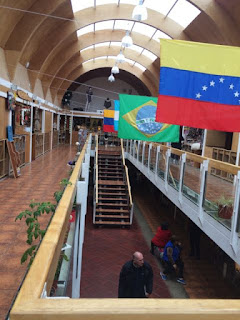The southern part of the South American continent is as
fractured as frost crystals, but the inlets, bays and passages around the
Strait of Magellan are home to a million wonders.
Actually we entered the Strait of Magellan on the 26th
in the late afternoon. We are getting where the sun does not set till 10 PM and
it will even set later when we get to Antarctica. Punta Arenas is the threshold
to them all. This strait takes its name from the Portuguese explorer, Ferdinand
Magellan, who discovered it in 1520.
As we approached the Strait the water was very rough, and
the captain made a hard turn and glasses went everywhere in the Lido. But then
it cleared up. On our way we saw the wreck of the USS Riverside, that was
commissioned in the county of Riverside CA in April of 1941 and decommissioned
in April of 1946. Once it was decommissioned it was sold to a South American
country as a container ship and in 1968 it sank here in the Strait of Magellan.
The Riverside was a troop transport in the Pacific in WWII. It brought soldiers
to Pearl Harbor and brought wounded back to the states. At the end of the war
it brought the troops home.
The hardy people who live here consider themselves first as
Magallanicos and second as Chileans. In order to come and go from this stormy
corner of the world, you have to either travel for days by bus across the
Argentine Patagonia, fly direct or take a lengthy cruise the rough the southern
seas. The California Gold Rush nurtured the port of Punta Arenas, which further
developed with wool and mutton in the late 19th century. However,
maritime traffic declined when the Panama Canal opened. Today, with a
population of 110,000, Punta Arenas attracts fishing vessels from the South Atlantic
as well as Antarctic research and cruise ships, and recently a duty free zone
has promoted commerce and encouraged immigration.
Most of the main attractions are concentrated around the
central square, with museums and mansions showcasing the interesting history of
this area from its pioneer days up to modern day. This is also a great jumping
off point to discover the richness of the area. From here, one can venture to
the high scarps of Torres del Paine National Park, the penguin colony at Seno
Otway or the Martian volcanic topography of Pali Aike National Park.
Here, though, we did not do any tours. This is a port that
we were at in 2010. We docked very early in the morning to take on supplies,
but then we anchored in the bay and we came in on a tender. There were two
other cruise ships in this port, the Celebrity Infinity and the Norwegian Sun.
The Sun is the ship that we came down here on in 2010. We tendered in and then
walked into town.
We started by going to a market where the had many handmade
goods for sale. Unfortunately, we live in Florida so do not need most of what
they are selling.
We then walked up to the Plaza de Armas, main square, where
there is a statue of Ferdinand Magellan. It is supposed to be good luck if you
kiss the foot.
Across from the square was the Cathedral and the Sara Braun
Palace.
Otherwise, we just walked around looking at the architecture
and what the town had to offer.
Yesterday Steve was looking at his pictures we had taken
back in 2010 and we were wondering why there were so few. Now we know. Tomorrow
we go around Cape Horn.























No comments:
Post a Comment